
6 best ways of leveraging automated analytics to unearth customer insights

Brooke Webber
February 17, 2024
Learn the top 6 strategies for harnessing automated analytics to uncover valuable customer insights. Discover how automation can revolutionize your understanding of consumer behavior and enhance business decision-making.
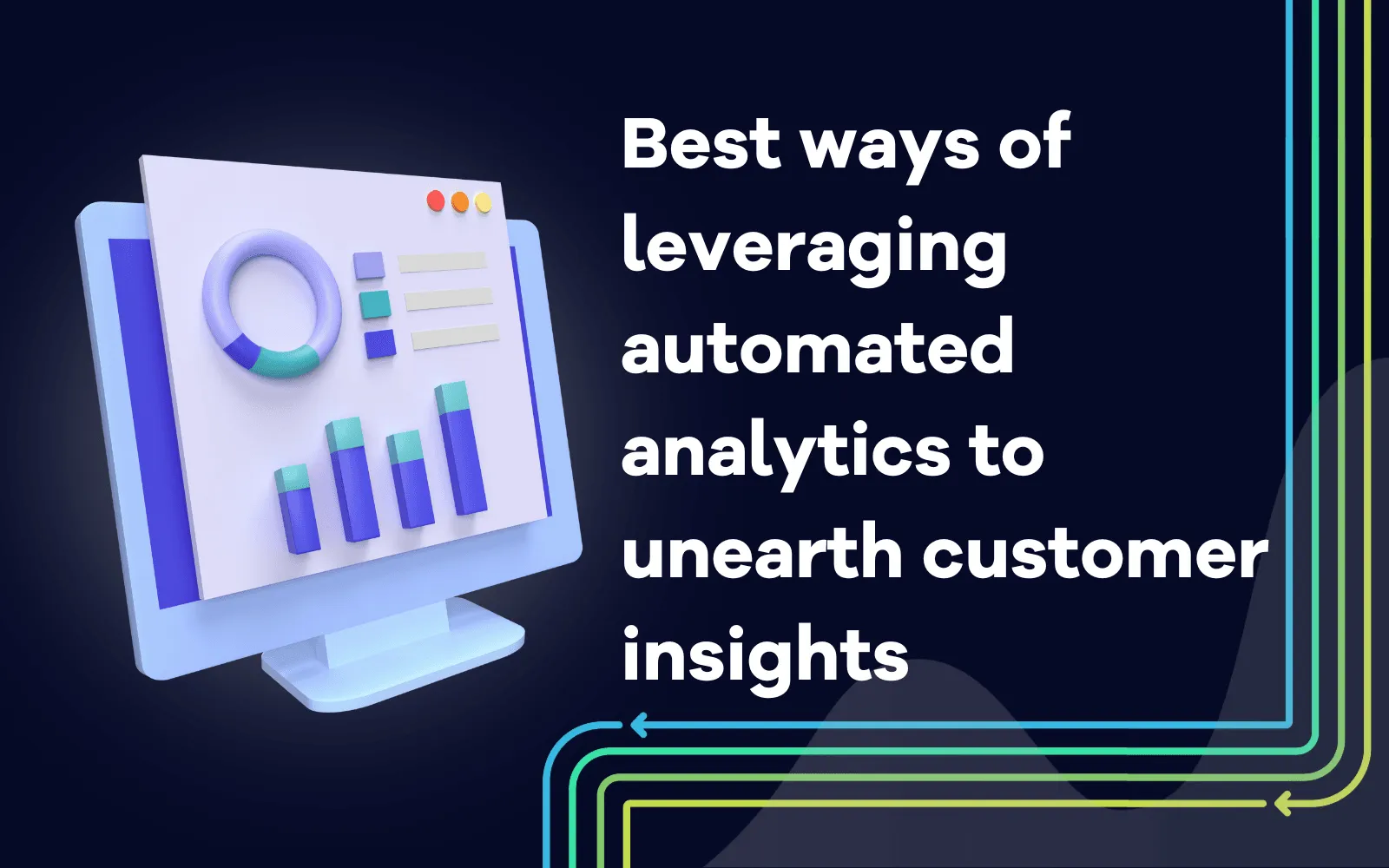
What product or service page is your customer looking at right now? Why has the previous buyer left and never returned to you? What exactly keeps your audience engaged, and what kills your website conversions?
There’s no need to worry if you can’t answer any of those questions just yet. Customer insights like these are “archeological finds” you are to dig out with the help of automated data analytics. We’ll show you how to do that in this guide.
While you read this, 52% of B2C and 25% of B2B companies already rely on customer data to drive their marketing decisions.
So, let’s gear you up with everything you need to transform your customer data into actionable insights and business growth.
What is customer data analytics?
Customer data analysis refers to methods and technologies used to collect, structure, and interpret customer information in real time.
These can be:
Web traffic data
Transactional data
Info about product/service usage
Behavioral patterns
Feedback data, etc.
From the definition, you can distinguish the three major tasks of customer analytics:
Task #1. Collect → capturing raw data from diverse sources (CRM system, social media platforms, email, website, etc.)
Task #2. Structure → classifying customer details and organizing them into chunks for further interpretation
Task #3. Interpret → deriving customer insights and making informed decisions.
The importance of data analytics in driving customer success
If the nineteenth century was about the gold rush, the twenty-first is about the “data rush.” Literally every business is on the hunt for customer data and invaluable insights from it. 84% of customer service leaders cite data analytics as extremely significant for their business goals.
But why the fuss, you ask?
Because nobody can deny the incredible benefits of customer data analytics. Discover them all below.
Visualized customer journeys
Real-time data analytics lets you notice every step your customers take during their buyer journey. You can then scrutinize all the layers of the customer journey as follows:
Stages (awareness, consideration, conversion, purchase, and loyalty)
Steps (browsing, clicking on the promo, adding to the cart, and so on)
Touchpoints (landing page, chatbot, newsletter, and others)
Departments (marketing, inventory management, logistics, customer support, etc.)

Source: Brightvessel.com
You can identify every pain point and eliminate the roadblocks by mapping out the customer journey like this.
Identified tendencies in customer behavior
One of the most significant advantages of data analytics is forecasting customer behavior based on the collected details. Thanks to predictive analysis, you can see how your customers tend to behave and what further actions to anticipate from them.
For instance, one of the customer behavior trends today is a growing demand for sustainable products: 66% of customers put sustainability first when purchasing. Noticing such a tendency among your target audience, you can showcase sustainable products right on the homepage of your eCommerce website to make them more visible for web visitors or highlight sustainable packaging as your top priority.
Personalized marketing strategies
Personalization is the key to customer satisfaction because that is what consumers want from brands. In fact, 71% of shoppers expect companies to provide a personalized experience, and 76% feel frustrated when they don’t get it.
And that’s when data analytics becomes a game-changer. It helps you uncover all customer needs and demands to personalize customer experiences with tailored marketing campaigns. It’s as if you feel your customer’s pulse and make your promotional messages resonate with it.
Higher customer retention
Who wouldn’t dream of reducing churn and keeping customers forever?
It is within the bounds of possibility if you use data analytics and customer insights driven from it.
This way, you can even turn your customers into lifelong fans. How exactly? By selecting the most effective retention strategies for every particular client based on their likes/dislikes, personality traits, values, lifestyle choices, etc. For example, you could diversify the list of rewards in your loyalty program and offer the most desirable perks according to your customer’s interests.
Improved SEO
After obtaining customer insights, you can boost your SEO efforts considerably. The knowledge of your user intent and search intent helps you achieve the following:
Smoother website navigation
Keyword-nourished homepage
Highly converting blog posts
Optimized product descriptions
Geo-targeting
Regarding the latter, it opens the doors to local SEO. Picture this. Your customer data analytics shows that you failed to reach your local audience. Your web traffic is geographically scattered. At this rate, you can start optimizing for local searches and getting targeted traffic and leads.
Boosted sales and revenue
With extracted customer insights, your marketing and sales teams get empowered to press the right buttons and drive your business growth. Your marketers will know what works better for lead generation to generate more qualified leads and convert them into buyers. Meanwhile, your salespeople will be able to develop a personalized approach to selling products or services to ensure excellent customer experiences.
In addition, here’s a fact worth sharing. Companies using customer data analysis extensively outperform their competition by 131% in sales and 126% in profits.
6 tips on using automated data analytics for customer insights
Below, we’ll cover the most essential things to keep in mind if you want to excel in customer data analysis.
Turn to AI-powered data analytics tools
The rise of artificial intelligence (AI) ushered in new business opportunities and truly reshaped how brands manage customer data.
Manual data analytics takes too much time and effort. Let alone the mistakes we, as humans, are prone to make. On the contrary, AI tools for data analysis provide faster and cost-efficient solutions. Besides, they dissect customer insights more accurately and comprehensively, delivering error-free reports for data-driven decisions.
Here’s a list of AI-based tools to perform customer data analysis automatically:
AccuRanker: for determining search intent
UserIQ: for calculating user health score and monitoring in-app activity
ChurnZero: for generating customer briefs and ideas to reduce churn
Hotjar: for visualizing buyer journeys
MonkeyLearn: for performing sentiment analysis
Treasure Data: for synchronizing data from all touchpoints into a unified customer profile
Thanks to predictive analytics algorithms, artificial intelligence easily pinpoints correlations and trends in customer behavior, often unnoticeable to the human eye.
Ensure data privacy and cybersecurity
According to IBM, 44% of data breaches during the pandemic leaked consumers’ info (names, passwords, emails, and even healthcare records). A recent study shows that 95% of organizations experienced at least one data breach in 2023.
When the cybersecurity risks are enormous, you must be very careful when collecting customers’ individual information for further data analysis.
For one thing, it is crucial to follow regulations like the General Data Protection Regulation (GDPR) in the European Union or the Privacy Act in the United States. It would also help to clarify the local data privacy laws established in 13 US states.
For another, you might need to reconsider your cybersecurity measures for higher consumer data protection:
Develop a transparent privacy policy and obtain explicit consent from individuals before processing their information
Encrypt sensitive data
Use web server firewalls and intrusion detection systems
Set up multi-factor authentication
Organize cybersecurity awareness training for employees
Design a cyber-incident response plan
Only 5% of companies apply all practices and policies for the security and privacy of customer data.
What about your company?
For a start, you should revisit your privacy policy and outline all third parties accessing your customer information. Besides, make sure to display a GDPR cookie consent message on your website with clear options to accept, reject, or customize the cookie settings.
Check out this one from s360 as an example.
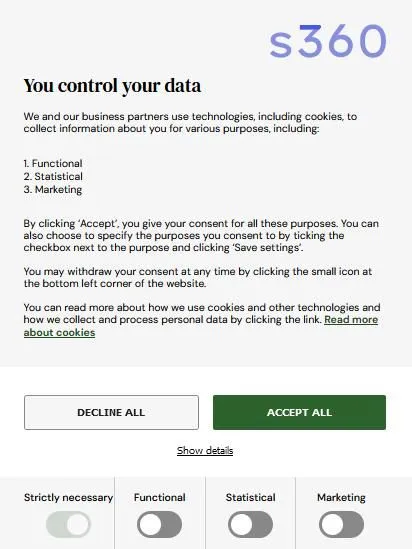
Source: s360digital.com
Take a multi-channel approach to data analysis
You must gain customer insights from different channels to get a more holistic view of your audience and create a solid digital marketing plan. The top three are the website, social media, and email.
Website
With website data analytics, you dig deeper into user data like overall traffic, unique page visits, content interactions, etc. For instance, you can collect rich user insights from a heatmap or an A/B test.
Let’s say you want to draw more leads into your sales funnel, but they don’t get in. You may not even notice it, but blatant mistakes in CTA design hurt your conversions. You can implement A/B testing and see which CTAs are more powerful in attracting potential clients.
Tools for website data analysis: Google Analytics 4 (aka GA4) – for traffic and engagement, AB Tasty – for A/B tests, Mouseflow – for heatmaps
Social media
Social media data analytics will give you in-depth insights into customer engagement with your posts and ads.
You can then understand how to engage your audience more effectively and leverage social media for sales, relying on the following factors:
Likes
Comments
Views
Shares
Impressions
Sentiment (positive, negative, or neutral)
For example:
The Leya AI team actively runs Meta ads (formerly - Facebook ads). However, the ad performance is different every time. Look at this video ad.

Source: Facebook.com
And now, here’s an image ad that gathered considerably fewer likes, comments, and shares.

Tools for social media data analysis: Buffer, Hootsuite, Social Insider
Email data analytics focuses on the following hallmarks in emails:
Deliverability
Open rate
Click-through rate
Reading time
Conversion rate
Unsubscribe rate, etc.
Once you translate these data into actionable insights, you can write stronger emails that delight and convert every customer.
Tools for email data analysis: HubSpot, Klaviyo, or SmartLead.ai
Roll out customer segmentation
Imagine you have accumulated customer data into one large pile.
What now?
Your next step would be customer segmentation.
By segmenting customers into distinct clusters or categories based on their shared characteristics, brands see more productive results in marketing.
Need numbers?
Here they are. After segmenting the B2B audience, Scorpion Healthcare increased conversions by 56% on LinkedIn. Besides, customer data segmentation has huge potential for email marketing. The open rates of segmented emails are typically 14.31% higher than those of non-segmented campaigns.
First, you should divide customers into groups and then create individual segmented profiles based on such characteristic features as:
Needs: requirements, concerns, pain points
Behavior: purchasing habits and behavioral patterns
Demographics: gender, ethnicity, age, education, occupation
Geography: state, region, climate, language, cultural preferences
Psychographics: interests, life values, moral code, temperament, character type
Firmographics (for B2B): industry, business type, company size, sales volume
Technographics (for B2B): devices, apps, innovations
For example:
Kinsta, a WordPress hosting provider, segments leads by firmographic factors like business size, number of workers/site, and others and diversifies the pricing options. Besides, prospective clients can discuss a customized plan with the sales team to fit their specific requirements (needs-based segmentation).

Source: Kinsta.com
Tools for segmenting customers: Heap, Glance, BlastPoint
Prioritize browse and cart abandonment data
Prioritizing and analyzing these data thoroughly, you may design effective browse- and cart-abandonment strategies to retain customers in an online store.
Let’s dwell on them in detail and explore some examples.
Abandoned browsing sessions
You get the browse-abandonment data from the situations when visitors view web pages but don’t buy anything and leave the site.
Did you know?
Out of 100 site visitors, 39 people scroll through products/services, but only four make a purchase.
Here’s a browse-abandonment email to get the lead back to the site from Lightning Card Collection, starting with “We noticed you checking out…”
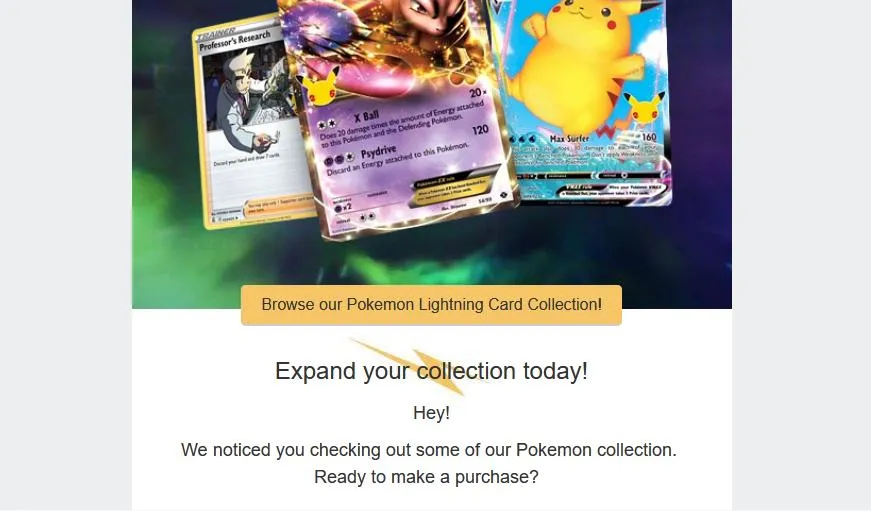
Alternatively, you can use irresistible lead magnets driven by interest (psychographic segmentation) to stop users from leaving. Learn from the example of Hubstaff. When reading Hubstaff’s article on managing a remote workforce, the blog visitor sees a popup with a free copy of the guide on remote team management.

Source: Hubstaff.com
Abandoned carts
Cart abandonment data are received from the scenarios when shoppers add items to their carts but then drop them, failing to checkout.
The average cart abandonment rate in eCommerce is 70.19%, meaning that only three customers out of ten complete the purchase after adding products to the cart.
What if your customers constantly abandon their carts?
Lure them back to the e-store to finish the purchase with a cart recovery email like this one from King Arthur Baking.
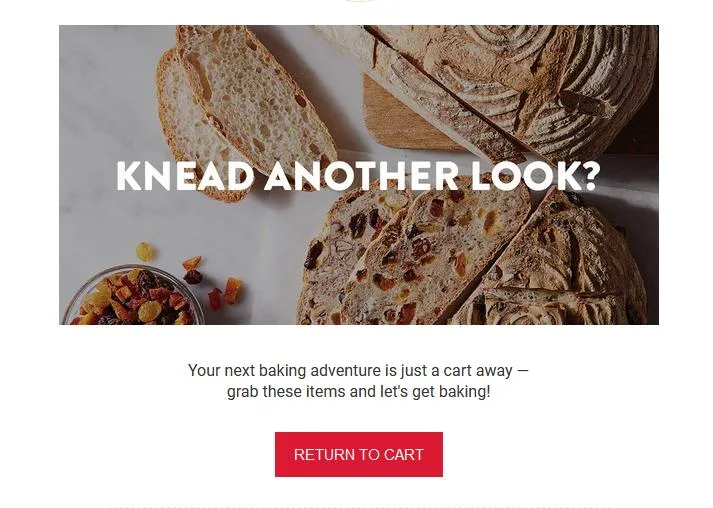
Tools for analyzing abandoned carts and creating targeted emails: CartStack, OptinMonster, Barilliance
Create a feedback loop
How is it going so far?
That’s pretty much the phrasing you can copy and save to ask your audience about their user experience with your product/service.
You can fully understand your audience and their expectations by gathering customer feedback consistently. For that, organize a continuous feedback loop with customer surveys like these:
Brand awareness survey
Product feedback survey
Segmentation survey
Event evaluation survey
Net promoter score (NPS) survey
Customer satisfaction score (CSAT) survey
Customer effort score (CES) survey, etc.
If you run a SaaS business, you can capture user feedback during a free trial. See how Keyhole does that.
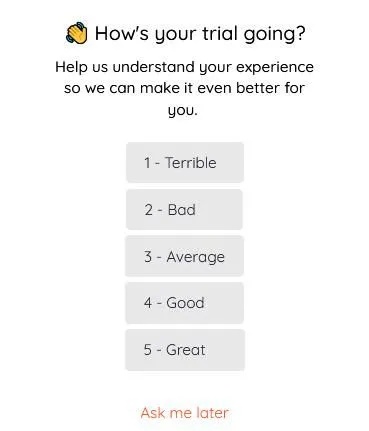
Source: Keyhole.co
Alternatively, embed feedback forms and surveys on your website. Look at this popup from LEGO.

Source: Lego.com
Yet another option is to send them via email and increase the participation rate by offering a prize or bonus. For example, Moosejaw provides a $10 reward for taking the survey.

Tools for analyzing customer feedback: Survicate, Qualaroo, InMoment, Feedier
Tame the avalanche of customer data with automated analytics
Brands focusing on customer insights analysis will always be one step ahead of their competitors because it’s the key navigator of positive shopping experiences, satisfaction, and loyalty.
This article has geared you up with proven tools and strategies to take customer data under control and manage their massive, dynamic, and rapidly changing amounts. Play a proactive game and achieve customer-centricity with data analytics automation.
Related blog posts

5 LLM Visibility Metrics You Should Track in 2026
SEO is now both about ranking in search engines and being visible in LLMs. We give you five visibility metrics every SEO should track in 2026.
3 December 2025Is LLM Tracking Relevant for You?
LLM tracking is not just for SEOs. It is also relevant for content teams, agencies, marketing leadership, and communication teams. Learn why here.
26 November 2025
How to Find the Best Prompts to Track for AI Visibility
Do you want to start tracking prompts to optimize your AI visibility? We give you seven practical ways to identify relevant prompts to track in LLMs.
9 November 2025
